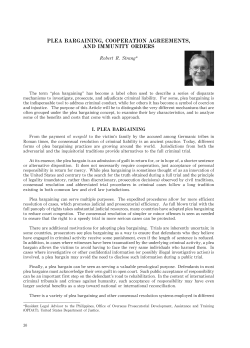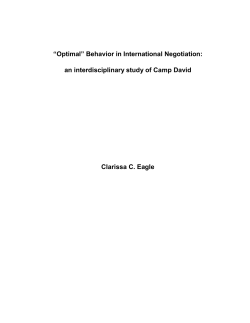
Plea and Charge Bargaining Research Summary
Plea and Charge Bargaining Research Summary Prepared by: Lindsey Devers, Ph.D. CSR, Incorporated 2107 Wilson Boulevard, Suite 1000 Arlington, VA 20001 www.csrincorporated.com Under Contract No. GS-10F-0114L, Order No. 2008-F_08151 Janaury 24, 2011 Contents Introduction ....................................................................................................................................... 1 Background ........................................................................................................................................ 1 Prosecutorial Discretion .................................................................................................................... 1 Legal Characteristics ........................................................................................................................ 2 Extralegal Characteristics ................................................................................................................ 2 Summary Findings ............................................................................................................................ 3 Policy Implications and Future Research ........................................................................................ 3 References .......................................................................................................................................... 4 i Research Summary: Plea and Charge Bargaining INTRODUCTION “Plea bargaining is a defining, if not the defining, feature of the federal criminal justice system” (Brown and Bunnell, 2006:1063). In plea bargaining, a defendant is faced with a charge at arraignment. Typically this is the maximum charge or punishment that the defendant will be held to if he or she goes to trial. The prosecutors will present the defendant with an opportunity to plead guilty to a lesser charge or to the original charge with less than the maximum sentence. In theory, the charge presented limits the penalties faced if the defendant decides to go to trial. While being found innocent or being acquitted is, of course, the best way for defendants to avoid jail time and other penalties, going to trial is perceived as risky, because it is impossible to predict what a jury will decide. As a result, many defendants enter pleas (Bar-Gill and Ben-Shahar, 2009). BACKGROUND According to the Bureau of Justice Statistics (2005), in 2003 there were 75,573 cases disposed of in federal district court by trial or plea. Of these, about 95 percent were disposed of by a guilty plea (Pastore and Maguire, 2003). While there are no exact estimates of the proportion of cases that are resolved through plea bargaining, scholars estimate that about 90 to 95 percent of both federal and state court cases are resolved through this process (Bureau of Justice Statistics, 2005; Flanagan and Maguire, 1990). There are a few theories as to whether the plea bargaining process is fair and equitable. Proponents argue that docket pressures are too great and that prosecutors lack the time to pursue all indictments because there are simply too many (Stuntz, 2004). Furthermore, defendants may not have the resources necessary to go to trial, especially if they are incapacitated and presented with an explicit outcome (Bar-Gill and Ben-Shahar, 2009). Those who are not in favor of plea bargaining argue that defendants are better off without it because each case would then be processed impartially. Prosecutorial budgets would only allow prosecution in those cases where there was strong evidence to convict. Thus, fewer innocent defendants would be coerced into guilty pleas. In addition, violent and chronic offenders would be less likely to receive lenient punishment. Consequently, some believe that without plea bargaining the number of cases coming to trial would remain the same or would be reduced (Bar-Gill and Ben-Shahar, 2009:740). This research summary will show that plea bargaining results in disparate treatment concerning both legal and extralegal characteristics, especially regarding those who are more likely to be granted lenient sentences. Moreover, the research will outline the discrepancies between those cases processed through plea bargaining and trials, and those when there is disparate treatment and defendants are granted greater leniency when a charge is reduced. Research shows that these discrepancies are primarily due to prosecutorial discretion. Each of these issues is discussed below. PROSECUTORIAL DISCRETION Some argue that the plea bargaining process is more cost efficient than having all cases go to trial. Furthermore, some researchers and legal scholars have reiterated that the practice is fair, just, and procedurally sound (Bar-Gill and Gazal-Ayal, 2006; Bowers, 2008; Brown and Bunnell, 2006; Goodman and Porter, 2002; Lee, 2005; McDonald and Cramer, 1992). While this process has been 1 Research Summary: Plea and Charge Bargaining deemed fair by some, numerous other researchers and practitioners find disparities within the system among those defendants who accept a plea and those who go to trial. The plea bargaining process has been criticized for allowing prosecutors too much discretion compared with judges, who are held to concise sentencing guidelines (Burke, 2007; Finkelstein, 1975; Ma, 2002). Prosecutors have been found to use threats that coerce defendants into accepting pleas to secure a conviction when the evidence in a case is insubstantial (Finkelstein, 1975). Moreover, several researchers have noted that prosecutorial biases can influence the plea bargaining process, because prosecutors are given such wide latitude when they reduce charges for offenders (Burke, 2007; Ma, 2002). Prosecutorial discretion also has resulted in harsher penalties for those defendants who opt for going to trial, rather than accepting a plea. Many researchers have found that those who go to trial are more likely to receive harsher sentences than those who accept a plea when comparable offenses are considered (Albonetti, 1991; Britt, 2000; Dixon, 1995; Engen and Gainey, 2000; Kurlychek and Johnson, 2004; Steffensmeier and Demuth, 2000, 2001; Steffensmeier and Hebert, 1999; Steffensmeier et al., 1993, 1998). Additionally, several methodologically sound studies have found that those who pled guilty were more likely to receive lighter sentences than those who would have gone to trial (King et al., 2005; Piehl and Bushway, 2007; Ulmer and Bradley, 2006). These studies have found the following: f Defendants tend to receive harsher sanctions if they exercise their right to a jury trial. f There is a wide range of prosecutorial discretion, and this varies greatly by region. f Punishment is determined by the seriousness and type of offense, prior criminal history, and the contextual characteristics of the court, including caseload volume, court community size, violent crime rates, and size of the region’s black population. Overall, the majority of evidence illustrates that those who accept a plea are likely to receive a lighter sentence compared with those who opt for a trial. This disparity exists because prosecutors are granted wide discretion when reducing charges. These findings are problematic because they demonstrate that if a defendant opts to invoke the Sixth Amendment right to a trial by jury, he or she will likely have a more unfavorable outcome. LEGAL CHARACTERISTICS Research shows that legal characteristics, such as the seriousness of the current offense and prior record, increase the likelihood that a defendant will plead guilty (Champion, 1989; Meyer and Gray, 1997; Ulmer and Bradley, 2006). Other known legal characteristics that increase the chance of accepting a plea include the defendant’s prior record; the seriousness of the crime committed; the strength of the evidence; the use of a public or private defender; and the detention status of the offender (Champion, 1989; Kellough and Wortley, 2002; Ulmer and Bradley, 2006). Pretrial detention has a strong effect on the decision to offer and accept pleas. Those who are taken into custody are more likely to accept a plea and are less likely to have their charges dropped (Kellough and Wortley, 2002). More generally, legal characteristics increase the likelihood of accepting a plea, because there is more uncertainty in outcomes for both chronic and more serious offenders. EXTRALEGAL CHARACTERISTICS Extralegal characteristics to consider in the research on plea bargaining include race, socioeconomic status, gender, and age. To date, research suggests that some extralegal characteristics make it more likely that a 2 Research Summary: Plea and Charge Bargaining defendant will not receive a reduced plea charge. Studies that assess the effects of race find that blacks are less likely to receive a reduced charge compared with whites (Farnworth and Teske, 1995; Johnson, 2003; Kellough and Wortley, 2002; Ulmer and Bradley, 2006). Additionally, one study found that blacks are also less likely to receive the benefits of shorter or reduced sentences as a result of the exercise of prosecutorial discretion during plea bargaining (Johnson, 2003). Studies have generally found a relationship between race and whether or not a defendant receives a reduced charge (Piehl and Bushway, 2007:116; Wooldredge and Griffin, 2005). While the relationship found between race and receiving a reduced plea has been consistent, research on other extralegal characteristics such as gender and age has shown mixed results. One study found that defendants who were younger or male were less likely to receive a reduced charge (Albonetti, 1992). Conversely, some evidence suggests that gender was not a significant factor in whether or not a defendant received a reduced plea. The most robust analysis suggests that both legal and extralegal characteristics are heavily influenced by prosecutorial discretion and by the region where the case is processed (Piehl and Bushway, 2007). Thus, whether a defendant receives a reduced charge may depend on where the case is processed and both extra and legal characteristics. SUMMARY FINDINGS f The overwhelming majority (90 to 95 percent) of cases result in plea bargaining. f Prosecutorial discretion in plea bargaining is known to cause discrepancies in sentencing outcomes. f Those who go to trial rather than accept a plea are more likely to receive harsher sentences. f Legal variables, including the seriousness of the current offense and prior record, are important factors in determining whether a charge will be reduced and by how much. f The majority of research on race and sentencing outcomes shows that blacks are less likely than whites to receive reduced pleas. f Evidence concerning gender and age in this research has been inconclusive. f Both legal and extralegal characteristics are heavily influenced by prosecutorial discretion and by the region where the case is processed. POLICY IMPLICATIONS AND FUTURE RESEARCH Prosecutorial discretion and legal and extralegal characteristics affect the plea bargaining process. Several avenues of concern arise when abolishing or reforming this process is considered. To date, two studies have investigated the impact of what happens to the system when plea bargaining is abolished. These studies found an increase in the number of cases brought to trial when plea bargaining was limited, and over time the number of convictions became more consistent (Heumann and Loftin, 1979; Holmes et al., 1992). Plea bargaining is an inherent part of the criminal justice system. An official ban on plea bargaining is therefore impractical. This has even been recognized by various scholars and policymakers who argue that the system is in need of reform (Barkow, 2006; Bibas, 2001, 2004; Bohm, 2006; Bowen, 2009; Brown, 2005; Gorr, 2000; Guidorizzi, 1998; Ma, 2002; Stuntz, 2004; Wright, 2005; Zacharias, 1998). Some alternative methods of plea bargaining are more realistic and include these options: f Limiting plea bargaining to certain types of charges, such as less serious crimes; 3 Research Summary: Plea and Charge Bargaining f Limiting prosecutorial discretion by creating policy and legislation that calls for firmer guidelines when choosing sanctions for specific crimes; and f Involving both judges and defense attorneys in the charge bargaining process so that there is more of a balance of power among all legal participants (Bibas, 2004). More generally, plea negotiations should be handled objectively and separately from the trying of cases (Uviller, 2000). The plea bargaining process is ingrained in the way cases are processed. Both reform and future research are needed to address the disparities within the system and to find a practical solution for all participants involved. REFERENCES Albonetti, C. (1991). An integration of theories to explain judicial discretion. Social Problems 38:247–66. Albonetti, C. (1992). Charge reduction: An analysis of prosecutorial discretion in burglary and robbery cases. Journal of Quantitative Criminology 8:317–333. Bar-Gill, O., and Ben-Shahar, O. (2009). The prisoners’ (plea bargain) dilemma. Journal of Legal Analysis 1:737–773. Bar-Gill, O., and Gazal-Ayal, O. (2006). Plea bargains only for the guilty. Journal of Law and Economics 49:353–364. Barkow, R. (2006). Separation of powers and the criminal law. Stanford Law Review 989, 1033–1034: 2–58. Bibas, S. (2001). Judicial fact-finding and sentence enhancements in a world of guilty pleas. Yale Law Journal 110:1097–1120. Bibas, S. (2004). The Feeney amendment and the continuing rise of prosecutorial power to plea bargain. Journal of Criminal Law & Criminology 94:295–309. Bohm, R. (2006). “McJustice”: The McDonaldization of criminal justice. Justice Quarterly 123:27–146. Bowen, D. (2009). Calling your bluff: How prosecutors and defense attorneys adapt plea bargaining strategies to increased formalization. Justice Quarterly 26:2–29. Bowers, J. (2008) Punishing the innocent. University of Pennsylvania Law Review 156:1117–1179. Britt, C. (2000). Social context and racial disparities in punishment decisions. Justice Quarterly 17:707–32. Brown, D. (2005). The decline of defense counsel and the rise of accuracy in criminal adjudication. California Law Review 93:585–1645. Brown, M., and Bunnell, S. (2006). Negotiating justice: Prosecutorial perspectives on federal plea bargaining in the District of Columbia. American Law Review 43:1063– 1093. Bureau of Justice Statistics (2005). State Court Sentencing of Convicted Felons. Washington, DC: U.S. Department of Justice. 4 Research Summary: Plea and Charge Bargaining Burke, A. (2007). Prosecutorial passion, cognitive bias, and plea bargaining. Marquette Law Review 93:183–211. Champion, D. (1989). Private counsels and public defenders: A look at weak cases, prior records, and leniency in plea bargaining. Journal of Criminal Justice 17:253–263. Dixon, J. (1995). The organizational context of criminal sentencing. American Journal of Sociology 100:1157–198. Engen, R., and Gainey, R. (2000). Modeling the effects of legally relevant and extralegal factors under sentencing guidelines: The rules have changed. Criminology 38:207–230. Farnworth, M., and Teske, R. (1995). Gender differences in felony court processing: Three hypotheses of disparity. Women and Criminal Justice 6:23–44. Finkelstein, M. (1975). A statistical analysis of guilty plea practices in the federal courts. Harvard Law Review 89:293–315. Flanagan, T., and Maguire, K. (1990). Sourcebook of Criminal Justice Statistics, 1989. Washington, DC: U.S. Department of Justice, Bureau of Justice Statistics. Goodman, J., and Porter, P. (2002). Is the criminal justice system just? International Review of Law and Economics 22:25–39. Gorr, M. (2000). The morality of plea bargaining. Theory and Practice 26:129–151. Guidorizzi, D. (1998). Should we really “ban” plea bargaining? The core concerns of plea bargaining critics. Emory Law Journal 47:753–783. Heumann, M., and Loftin, C. (1979). Mandatory sentencing and the abolition of plea bargaining: The Michigan Felony Firearm Statute. Law and Society Review 13:393–430. Holmes, M, Daudistel, H., and Taggart, W. (1992). Plea bargaining policy and state district court caseloads: An interrupted time series analysis. Law and Society Review 26:139– 160. Johnson, B. (2003). Racial and ethnic disparities in sentencing departures across modes of conviction. Criminology 41:449–490. Kellough, G., and Wortley, S. (2002). Remand for plea: Bail decisions and plea bargaining as commensurate decisions. British Journal of Criminology 42:186–210. King, N., Soule, D., Steen, S., and Weidner, R. (2005). When process affects punishment: Differences in sentences after guilty plea, bench trial, and jury trial in five guideline states. Columbia Law Review 105:960–1009. Kurlychek, M., and Johnson, B. (2004). The juvenile penalty: A comparison of juvenile and young adult sentencing outcomes in criminal court. Criminology 42:485–515. Lee, S. (2005). The scales of justice: balancing neutrality and efficiency in plea bargaining encounters. Discourse & Society 16:33–44. Ma, Y. (2002). Prosecutorial discretion and plea bargaining in the United States, France, Germany, and Italy: A comparative perspective. International Criminal Justice Review 12:22–52. McDonald, W., and Cramer, J. (1992). Plea Bargaining. Lexington, MA: D.C. Heath. Meyer, J., and Gray, T. (1997). Drunk drivers in the courts: Legal and extra-legal factors affecting pleas and sentences. Journal of Criminal Justice 25:155–163. 5 Research Summary: Plea and Charge Bargaining Pastore, A., and Maguire, K. (2003). Sourcebook of Criminal Justice Statistics: 2002. Washington, DC: U.S. Government Printing Office. Piehl, A., and Bushway, S. (2007). Measuring and explaining charge bargaining. Journal of Quantitative Criminology 23:105–125. Steffensmeier, D., and DeMuth, S. (2000). Ethnicity and sentencing outcomes in U.S. federal courts: Who is punished more harshly? American Sociological Review 65:705–29. Steffensmeier, D., and DeMuth, S. (2001). Ethnicity and judges’ sentencing decisions: Hispanic-Black-White comparisons. Criminology 39:145–78. Steffensmeier, D., and Hebert, C. (1999). Women and men policymakers: Does the judge’s gender affect the sentencing of criminal defendants? Social Forces 77:1163–196. Steffensmeier, D., Kramer, J., and Streifel, C. (1993). Gender and imprisonment decisions. Criminology 31:411–46. Steffensmeier, D., Ulmer, J., and Kramer, J. (1998). The interaction of race, gender, and age in criminal sentencing: The punishment cost of being young, Black, and male. Criminology 36:763–98. Stuntz, W. (2004). Plea bargaining and criminal law’s disappearing shadow. Harvard Law Review 117:2548–2569. Ulmer, J., and Bradley, M. (2006). Variation in trial penalties among serious violent offenses. Criminology 44:631–670. Uviller, R. (2000). The neutral prosecutor: The obligation of dispassion in a passionate pursuit. Fordham Law Review 68:1695–1718. Wooldredge, J., and Griffin, T. (2005). Displaced discretion under Ohio sentencing guidelines. Journal of Criminal Justice 33:301–316. Wright, R. (2005). Trial distortion and the end of innocence in federal criminal justice. University of Pennsylvania Law Review 154:79–156. Zacharias, M. (1998). Suggested reforms for plea bargaining. Law and Society Review 25:24–37. 6
© Copyright 2025













